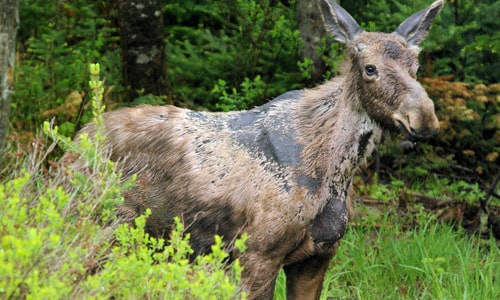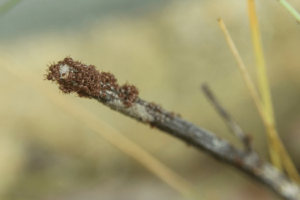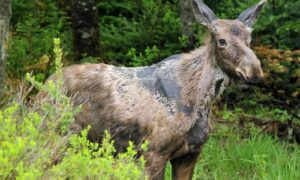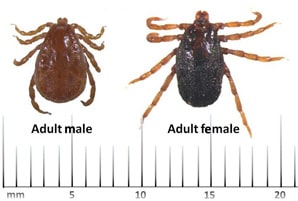
David vs. Goliath, The story of Moose and Winter Tick
By: Andrew Czwakiel, Harry French, and Jon Rheinhardt
For the bibliography please view this public access Google Doc link
Moose may be some of the most intriguing animals in the entire world. Moose populations have always been important ecologically and culturally in much of the northern United States (Ellingwood, 2018). In the northern New England states there are currently over 60,000 moose spread throughout the region. Sadly moose populations have not been faring well due to a small but destructive enemy. Ticks. The emergence of these tiny terrors has had terrible impacts on the populations of moose. For example, in New Hampshire the moose population was around 7,500 in the mid-90s but as of 2015 had been reduced to 4,000. And it is known that this population was not diminished due to hunting or habitat loss, with hunting being limited and habitats being protected since the 1980s. The diminished populations of moose have been connected to the increase in winter ticks (Jones, 2016). The primary effect ticks have on moose are through events known as epizootics, which are events where moose calves experience mortality rates over 50%.
Winter ticks or ‘moose’ ticks, are not a new factor affecting moose populations, and neither are the epizootic events they cause. Instead the main focus of concern is how often these events are occurring. There are two main facto rs that contribute to the frequency of epizootic events. Shorter winters and dense moose populations have created the perfect scenario for winter ticks to explode in population. Winter ticks are completely parasitic and require a host in order to survive the low winter temperatures. Conditions becoming warmer and therefore more survivable for longer without a host allows more time for ticks who would have otherwise died to find one (Maine Moose, 2020). Winter ticks are not only at risk of dying as a result of colder temperatures, but their overall effectiveness at finding a host is negatively affected. When temperatures are colder, it takes longer for larval ticks to react. The questing larval cluster, when stimulated, will reach out with their forelimbs to grasp the host. In colder temperatures this reaction speed is slowed and reduces the likelihood of successfully latching (Samuel et al., 2000).
rs that contribute to the frequency of epizootic events. Shorter winters and dense moose populations have created the perfect scenario for winter ticks to explode in population. Winter ticks are completely parasitic and require a host in order to survive the low winter temperatures. Conditions becoming warmer and therefore more survivable for longer without a host allows more time for ticks who would have otherwise died to find one (Maine Moose, 2020). Winter ticks are not only at risk of dying as a result of colder temperatures, but their overall effectiveness at finding a host is negatively affected. When temperatures are colder, it takes longer for larval ticks to react. The questing larval cluster, when stimulated, will reach out with their forelimbs to grasp the host. In colder temperatures this reaction speed is slowed and reduces the likelihood of successfully latching (Samuel et al., 2000).
Moose calves are particularly at risk of winter tick infestation. Calves who survived the summer and range from 10-11 months old get invaded by large numbers of winter tick larvae during the period of September to early November (Healy et al., 2018). Winter ticks are specifically adept at invading moose populations because when they quest for a host they climb vegetation and rest at a moose’s shoulder or stomach height (Holmes et al., 2018). This however only accounts for the mechanism of reaching a moose. Winter tick numbers on calf mortalities have been recorded at over 46,000 ticks on average per mortality (Jones et al., 2017). The behavior associated with this extreme number of ticks per host is that while questing, ticks aggregate with hundreds of individuals by locking their rear limbs to the others (Holmes et al., 2018). When a host brushes against the vegetation harboring the mass of parasites, they latch on. Once attached winter ticks remain throughout their life cycle, with the females dropping off after becoming engorged to lay their eggs in late spring. When compared to other species affected by winter tick, moose were found to have approximately 230x more ticks (Samuel et al., 2000). This has been associated with moose grooming behavior differing from that of the other species . It is hypothesized that moose, evolutionarily, have only recently been exposed to winter ticks. This is believed due to moose’s grooming behavior being ‘stimulus-driven’ (Samuel et al., 2000; Healy et al., 2020; Holmes et al., 2018). This lack of adaptation has, as previously mentioned, led to calves being particularly vulnerable to parasitism of winter ticks. Adults, while still at risk of infestations, are metabolically less impacted because their overall body size is able to counter the negative effects of the parasites (Musante et al., 2007). Calves on the other hand experience an energy deficit that leads to anemia and eventually death (Ellingwood, 2018).
. It is hypothesized that moose, evolutionarily, have only recently been exposed to winter ticks. This is believed due to moose’s grooming behavior being ‘stimulus-driven’ (Samuel et al., 2000; Healy et al., 2020; Holmes et al., 2018). This lack of adaptation has, as previously mentioned, led to calves being particularly vulnerable to parasitism of winter ticks. Adults, while still at risk of infestations, are metabolically less impacted because their overall body size is able to counter the negative effects of the parasites (Musante et al., 2007). Calves on the other hand experience an energy deficit that leads to anemia and eventually death (Ellingwood, 2018).
Research has been looking into ways to help the moose populations in New England. Potentially implementing methods to limit tick populations and increasing the number of moose calves would be the most beneficial. Another method would also be to manage moose population density to keep them at safe levels, which would prevent tick populations from booming. The control placed on population density would likely lead to higher rates of moose calf survival. Increasing the number of permits issued to hunt moose is also a management tactic that has been proposed by MDIFW (Maine Moose, 2020). This tactic would be used to lo wer the density of moose populations to subsequently lessen the population of winter ticks. This tactic could potentially be effective and would be supported by the hunting community but would need significant public outreach. It has the potential to be seen as too harsh if the goal is misunderstood. Despite this, lessening the density of winter tick in areas where their population was booming would allow moose to return in a healthier situation for adult reproduction and calf survival. The viability for this method stems from the fact that moose habitat in New Hampshire has been maintained by regular forest harvesting so it is more important currently to focus directly on the moose-tick interactive causes. Further research into management efforts and tactics is needed. However, if they can be applied to better Maine moose calf survival we suspect the Maine population as a whole would grow.
wer the density of moose populations to subsequently lessen the population of winter ticks. This tactic could potentially be effective and would be supported by the hunting community but would need significant public outreach. It has the potential to be seen as too harsh if the goal is misunderstood. Despite this, lessening the density of winter tick in areas where their population was booming would allow moose to return in a healthier situation for adult reproduction and calf survival. The viability for this method stems from the fact that moose habitat in New Hampshire has been maintained by regular forest harvesting so it is more important currently to focus directly on the moose-tick interactive causes. Further research into management efforts and tactics is needed. However, if they can be applied to better Maine moose calf survival we suspect the Maine population as a whole would grow.
